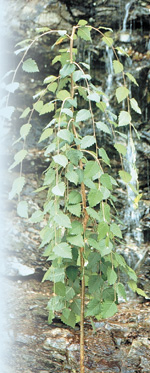New River Birch in Weeping Form
go.ncsu.edu/readext?236079
en Español / em Português
El inglés es el idioma de control de esta página. En la medida en que haya algún conflicto entre la traducción al inglés y la traducción, el inglés prevalece.
Al hacer clic en el enlace de traducción se activa un servicio de traducción gratuito para convertir la página al español. Al igual que con cualquier traducción por Internet, la conversión no es sensible al contexto y puede que no traduzca el texto en su significado original. NC State Extension no garantiza la exactitud del texto traducido. Por favor, tenga en cuenta que algunas aplicaciones y/o servicios pueden no funcionar como se espera cuando se traducen.
Português
Inglês é o idioma de controle desta página. Na medida que haja algum conflito entre o texto original em Inglês e a tradução, o Inglês prevalece.
Ao clicar no link de tradução, um serviço gratuito de tradução será ativado para converter a página para o Português. Como em qualquer tradução pela internet, a conversão não é sensivel ao contexto e pode não ocorrer a tradução para o significado orginal. O serviço de Extensão da Carolina do Norte (NC State Extension) não garante a exatidão do texto traduzido. Por favor, observe que algumas funções ou serviços podem não funcionar como esperado após a tradução.
English
English is the controlling language of this page. To the extent there is any conflict between the English text and the translation, English controls.
Clicking on the translation link activates a free translation service to convert the page to Spanish. As with any Internet translation, the conversion is not context-sensitive and may not translate the text to its original meaning. NC State Extension does not guarantee the accuracy of the translated text. Please note that some applications and/or services may not function as expected when translated.
Collapse ▲
‘Summer Cascade’
Photo by Thomas G. Ranney
Horticulturists are always looking for plants that are new and different. Many cultivars of plants are developed but few gain marketplace popularity. A new type of river birch, ‘Summer Cascade,’ looks to be one of those special plants that is unique enough to make its mark in North Carolina landscapes.
‘Summer Cascade’ is a weeping form of river birch that was discovered by John and Danny Allen at Shiloh Nursery in Harmony, N.C. The river birch is one of our landscape mainstays with its handsome peeling bark, and a weeping form promises something really special. Because of their unique growth habit, weeping plants are often used as specimen plants in the landscape. River birch, like many native plants, is very dependable and has few major pest problems. ‘Summer Cascade’ is considered to be a fast grower. It will form a mounded shrub or small tree if left untrained or it can be provided with trunk support and trained into a tree form.
The development of this tree is a good example of how significant achievements can be realized when a private business and a land-grant university work together. Shiloh Nursery worked with Dr. Tom Ranney, an N.C. State researcher at the Mountain Horticultural Crops Research Station in Fletcher, to determine how easily the plant could be propagated. Plants that are difficult for nurserymen to propagate are likely to be limited in commercial availability regardless of how many features they possess. Dr. Ranney found that ‘Summer Cascade’ can be rooted easily from stem cuttings.

‘Summer Cascade’
Photo by Thomas G. Ranney
A number of North Carolina nurseries are now growing ‘Summer Cascade.’ Specimens can be seen at the JC Raulston Arboretum in Raleigh, the Mountain Horticultural Crops Research Station in Fletcher and the North Carolina Arboretum in Asheville. Widespread availability is expected in a couple of years so Carolina gardeners can enjoy this exciting new introduction.
Kevin Starr


